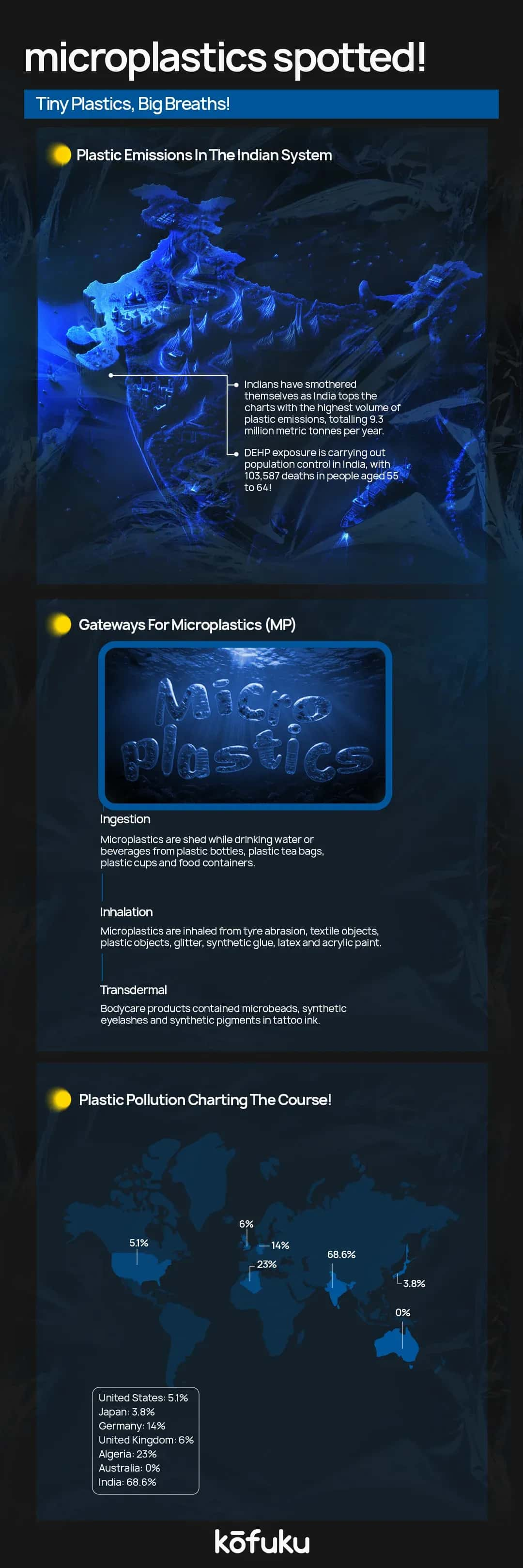Home
Blogs
Wellness Corner
How Common Household Plastic is Increasing Cardiovascular Disease Risk in India
How Common Household Plastic is Increasing Cardiovascular Disease Risk in India


Introduction
It was a regular Sunday morning. Meera was packing her lunch for the office. Rice, sabji, and dal, the ultimate desi meal packed with nutrients, all neatly stored in a bright plastic tiffin box she bought on sale.
She poured hot dal into a plastic container, popped it into the fridge, and then reheated it in the microwave later for lunch. By evening, she was browsing through offers for a new plastic water bottle set because the old ones had “the smell again.”
Everything seemed perfectly ordinary. But in Meera’s home, as in millions across India, something invisible was quietly lurking. It was not a burglar or a worm, but instead, common, everyday plastic leaching chemicals into her food and water.
Chemicals that, as research now shows, could be harming their hearts. So come along and learn more about these deadly chemicals that are slowly poisoning us.
Can Plastic Really Hurt Your Heart?
Yep, as dramatic as it sounds, science is starting to uncover that certain plastics, especially when heated, scratched, or used repeatedly, can release harmful substances into our food and water.
These substances, like bisphenol A (BPA) and phthalates, are called endocrine disruptors. That means they mess with your hormones, and when your hormones go out of balance, your heart pays the price.
In India, where plastic is used on a regular basis from storage jars to roadside chai cups, this is becoming a growing concern.
The connection, you may ask?
Well, phthalates are chemicals added to plastics to make them softer, more flexible, and longer-lasting. But it doesn’t come free, it comes with danger! These same chemicals may cause inflammation in the heart’s arteries, potentially leading to death.
Recent research analysing global health data found that exposure to a specific type of phthalate called DEHP (di(2-ethylhexyl) phthalate) may be behind the death of over one lakh Indians, among whom people were mainly aged 55 to 64.
So, where are phthalates coming from?
They’re hidden in everyday items: food packaging, skincare products, medical devices, even children’s toys. These chemicals can leach into food and be absorbed through the skin.
And once this bugger is inside the body, they disrupt hormones, causing blood vessel inflammation, and raise the risk of heart attacks plus high blood pressure.
Additionally, the chemicals are found in common products like pipes, garden hoses, medical tubes, raincoats, and more. It’s unavoidable, but awareness is the first step to reducing the risk.

But Wait, Aren’t Some Plastics Safe?
Yes and no. Despite the new plastic sellers declaring that they are BPA-free, we can’t be sure because they can release other questionable chemicals. And let’s be honest, how many of us even check those tiny recycling codes at the bottom of the box before pouring hot soup into it?
In many Indian households, plastic use is casual and constant. Plastic dabba goes without hesitation from the countertop to the fridge to the microwave. We drink water from tanks that sit in the sun for hours. And disposable cups? Oh, they’ve become a trend at parties and picnics besides the regular train stations.
But, Why Does It Matter More in India?
India has a growing number of cardiovascular diseases. The number has skyrocketed from 271 million to 529 million between 1990 and 2019. While we do have other reasons that contribute heavily to this number, plastics are slowly becoming a large contributing factor as well.
So if you are one of the 529 million unlucky souls, adding high plastic exposure to the mix from online deliveries, and you’re only making a dangerous cocktail. Especially because public awareness is low, we think more about food choices than whether the containers are even safe.
Secondly, plastic regulation is weak and heavily lobbied; many items sold in markets are unlabelled or non-food grade, but we buy them because they are a good deal and because of their appearance.
Thirdly, heat is a trigger; we are aware how hot India can get, and the climate can speed up chemical leaching from plastic into food and water. That’s why never drink the water you’ve left in the car for hours!
What Can Be Done (Without Going Broke)?
Don't worry, I won’t ask you to toss out your whole kitchen thoroughly; utensils are expensive! Here are small but powerful changes -
-
Avoid plastics as much as you can
-
Don’t put plastic containers in the microwave or dishwasher
-
Don’t reuse the same plastic containers if they're cracked or smell off
-
Use unscented lotions and laundry detergents
-
Add more glass, stainless steel, ceramic, or wood to hold and store foods.
-
Skip canned or processed items
-
Frequent handwashing to remove chemicals from hands.
-
Skip air fresheners and all plastics labelled as No. 3, No. 6, and No. 7. These numbers, also called Resin Identification Codes, help with recycling by indicating the chemical property of the plastic.

Conclusion
In the end, it’s not just about being eco-conscious or eco-friendly anymore. It’s about being heart-conscious. The choices we make in our kitchens, lunch boxes, and grocery bags ripple into our health over time.
So maybe next time, like Meera, you'll pause when you reach for that familiar plastic container. Perhaps you’ll grab the glass container one instead, which Meera’s colleague opts for. Because protecting your heart might just start with changing your tiffin box.
FAQs
Q. How are plastics linked to cardiovascular disease (CVD)?
A. Plastics, especially single-use and food-grade plastics, can release harmful chemicals such as Bisphenol A (BPA) and phthalates. These chemicals are endocrine disruptors, meaning they interfere with hormone systems.
Long-term exposure is linked to increased blood pressure, arterial stiffness, inflammation, and insulin resistance — all of which are risk factors for CVD.
Q. Which household plastics are most concerning?
A.: Plastic water bottles (especially reused ones), food containers (especially microwaved or exposed to heat), packaged food wrappers, baby bottles, non-stick cookware coatings, plastic wraps and zip-lock bags, plastics labeled with recycling codes 3 (PVC), 6 (PS), and 7 (Others) often contain harmful additives.
Q. What are microplastics, and how do they contribute to CVD?
A. Microplastics are tiny plastic particles that enter the human body through food, water, and air. They can trigger inflammatory responses, cause oxidative stress, and disrupt lipid metabolism.
Q. Is the Indian government doing anything about this?
A. Yes. India has banned certain single-use plastics since 2022 and initiated awareness campaigns on plastic hazards. However, the regulation of food-grade plastics and labelling is still under development and is not uniformly enforced.
Q. Can children and pregnant women be more vulnerable to plastic-related heart risks?
A. Yes. Children and pregnant women are especially vulnerable to the effects of plastic-related chemicals like BPA and phthalates. During pregnancy, these chemicals can cross the placenta and may disrupt fetal cardiovascular development.
In children, early exposure can affect the developing endocrine and immune systems, increasing their long-term risk of hypertension, obesity, and heart disease later in life.





